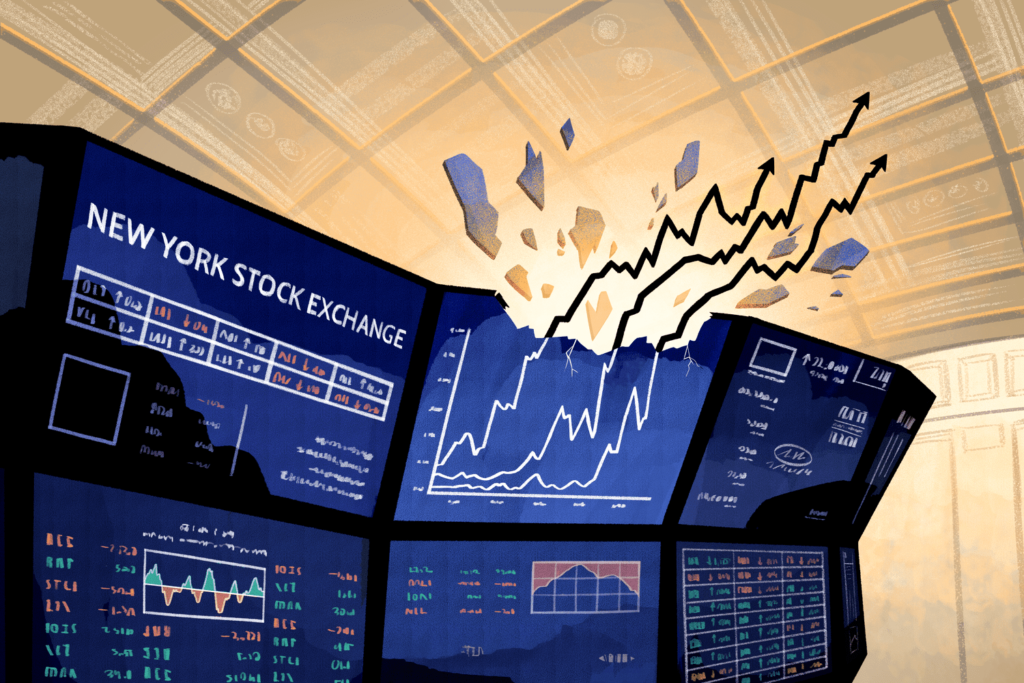Key Takeaways
- The S&P 500 rose nearly 4% in the second quarter, buoyed by surges in semiconductor and big tech stocks as the bulk of the index fell.
- The AI theme went beyond technology: Utilities and green energy stocks soared as Wall Street considered the massive power demands of the AI revolution.
- There are several trends that have analysts concerned heading into the second half of the year, including narrow market breadth, overstretched semiconductor stocks and the S&P 500’s concentration in tech.
The stock market is fresh off a strong second quarter, driven by big tech stocks, and that’s making some analysts nervous.
The market-capitalization-weighted S&P 500 rose 3.9% for the quarter and closed at a record high for the ninth time, but the equal-weighted index is down 3.1% from its record high at the end of the first quarter.
The discrepancy is largely due to the artificial intelligence theme that powered Nvidia’s (NVDA) 36% quarterly gain and Apple’s (AAPL) recovery from a weak first quarter. Both tech giants, both valued at more than $3 trillion entering the second half of the year, helped make a lackluster market look hot.
AI Boosts Semiconductor Stocks—But Not Just Semiconductor Stocks
Of the 11 sectors in the benchmark S&P 500, just three outperformed or matched the broader index in the second quarter: information technology (up 13.6%), communication services (up 9.1%) and utilities (up 3.9%). Roughly 25% of S&P 500 stocks outperformed the broader index.
Within the technology industry, there was a big difference between the quarter’s winners and losers: semiconductors was the only component of the sector to outperform the S&P 500.
Nvidia shares continued to rise, briefly becoming the world’s most valuable company. Chipmaker Broadcom (AVGO) surged after its ongoing AI infrastructure build-out boosted quarterly sales, and Qualcomm (QCOM) rose after unveiling a new on-device AI processor.
However, software fell 3% for the quarter, while the Internet Services and Infrastructure industry was down nearly 7%. Software giant Salesforce (CRM) plunged in early June due to weak sales and weak guidance. Smaller software stocks like Shopify (SHOP), Workday (WDAY), and MongoDB (MDB) also fell on disappointing results.
Oracle (ORCL) shares soared not because of stellar financial results (sales and profits fell short of expectations) but because the company announced a cloud partnership with Microsoft (MSFT) and OpenAI.
Investors have been so interested in artificial intelligence stocks that they’ve looked beyond chipmakers to find sellers in the AI revolution. The second-best performer on the S&P 500 after Nvidia was First Solar (FSLR), whose shares rose in early May after analysts wrote about the company as a potential beneficiary of AI.
Utilities are a quiet corner of the market typically favored by income-focused investors, but they’ve been performing like a high-growth sector. Vistra (VST), which joined the S&P 500 in May after its stock price soared 80% in the first quarter, is one of the index’s top stocks. NRG Energy (NRG) and NextEra Energy (NEE) have each risen more than 10%.
Some analysts see internal problems
But outside of that part of the market, the second quarter was pretty tough.
The energy, financial, health care, industrial, materials and real estate sectors have all fallen since March. Nearly 60% of the S&P 500 ended the quarter in the red.
The disconnect between the S&P 500 and most of its constituents was on full display in June, when the index smashed record after record amid a surge in Nvidia and other semiconductor stocks. But the S&P 500’s advance/decline line, which tracks the percentage of stocks that advance versus decline, began to slide, a sign of trouble brewing beneath the surface.
On June 12, when the S&P 500 hit its fifth quarterly record, “only 34% of S&P 500 stocks closed above their short-term 20-day moving average, the lowest percentage recorded in conjunction with a new high since data began in 1990,” said Adam Turnquist, chief technical strategist at LPL Financial.
What’s next for the stock market?
Some market watchers believe there is more room for the bull market to continue, especially if second-quarter earnings are in line with expectations. Only three sectors — consumer staples, industrials and materials — are expected to report declines in earnings in the second quarter. Seven sectors are expected to report earnings growth of more than 5%. Evidence that corporate profits are holding up could help extend stock price gains.
History is also on the market’s side: A first-half gain of 10% or more leads to a rise of more than 80% for the S&P 500, while the average second-half gain is about 8%.
Still, the narrowing range is just one of several warning signs analysts have been sounding in recent weeks.“The lack of confirmation on the recent breakout doesn’t mean the end of the bull market, but it does increase the risk of a pause or pullback unless the rally extends,” Turnquist said.
Analysts at Piper Sandler issued a similar assessment on Tuesday, saying a correction was “likely.” Analysts noted that momentum faded towards the end of the month, while defensive stocks began to gradually join the ranks of the market’s top performers.
He also cited the index’s heavy concentration in technology companies — Microsoft, Nvidia and Apple have a combined market capitalization four times that of the entire Russell 2000 small-cap index — and overexpansion of semiconductor stocks as concerns.

